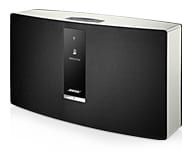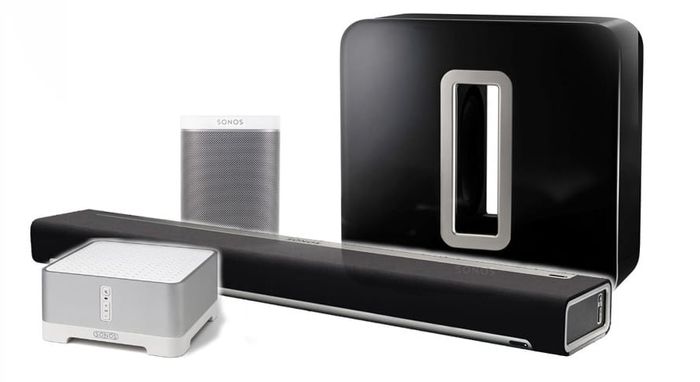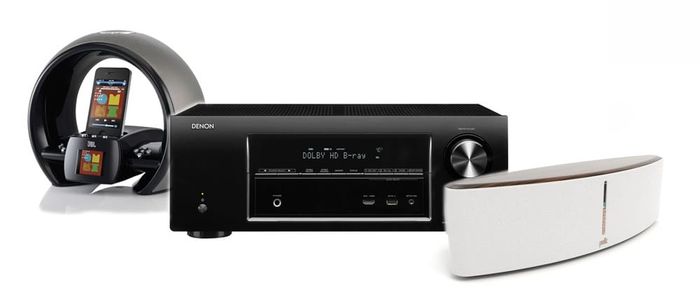In the past, wiring a finished home for whole house audio was extremely tricky. It involved hundreds of feet of speaker wire, long drill bits, fish tape, squirming through attics and crawl spaces and probably a fair amount of cursing. At the end of the day (if you were lucky enough to finish in a day) you were itchy, sore and tired. Hopefully you’d never move 'cause then you'd have to start from scratch.
Luckily, wireless technology has advanced enough to provide a viable alternative to the wired home. Let’s take a look at the most popular players in the wireless speaker market and see if any of these solutions can work for you.
Bose® SoundTouch™
Bose SoundTouch Highlights
- AirPlay compatible
- User friendly
- 6 programmable presets
- App controlled system
- Single or multi-room system
- Uses existing Wi-Fi network

Launched in October 2013, Bose® SoundTouch™ is designed for streaming digital music in one or multiple rooms throughout the house. Available models include the SoundTouch 30 for larger rooms, SoundTouch 20 for medium sized rooms and SoundTouch Portable which offers 2.5 hours of cord free play time with its rechargeabele lithium-ion battery. Having been turned on, these speakers connect to an existing Wi-Fi network to access internet radio, Pandora, and more. SoundTouch can also pull music files from network connected PCs for full access to your music collection. With integrated AirPlay compatibility which allows users to stream music wirelessly from an iPhone, iPod Touch or other apple device. The SoundTouch speakers can be controlled from a tablet, smartphone or computer using a simple app. As users purchase additional SoundTouch speakers, each device can play different music or you can sync them together in party mode. Bose released 3 speakers to start and plans to add many more soon.
Sonos
Sonos Highlights
- Wide selection of music
- Wi-Fi not required
- Single or multi-room system
- Wireless 5.1 theater option
- Easily add additional zones
- App controlled
- Expandable to 32 zones
- Optional wireless sub
- Link to existing stereo / speakers
- Works with i-Tunes library

The original whole-house audio innovators are still going strong and are hugely popular. They also has several speakers of different sizes to choose from based on your room size. Unlike Bose, Sonos does not use the Wi-Fi network in the home. Instead, only one Sonos device (Sonos Bridge) is hard-wired to a router or network. Once this connection is made, it creates its own wireless network independent from your Wi-Fi network. Not only does this un-burden your router from additional traffic, but it allows your Sonos network to expand and strengthen as you add more speakers. This is especially handy in larger houses, detached garages or homes using metal, concrete or other materials that would hamper a traditional Wi-Fi signal. Like the Bose system, Sonos is controlled using a tablet, smartphone, or computer with an intuitive app.
The scope of available music is extremely impressive with Sonos. Not only can users enjoy music from internet radio and networked computers, but they have access to a large selection of additional content. Spotify, Pandora, iHeartRadio, Amazon CloudPlayer, Slacker, and Rhapsody are only a few of the services that are compatible with Sonos. Their library of available content is so complete, they claim that users have the ability to “stream all the music on earth”.
The various sizes of speakers allow for true customization. Users can choose to buy just one speaker for a room or easily add a second speaker for true stereo separation. The speakers are available in various sizes and include a low-profile soundbar and wireless subwoofer for deep bass. For a true theater sound, users can combine the soundbar with four additional wireless speakers and the sub for a true 5.1 theater sound. One big difference with the Sonos platform is the ability to link up existing audio gear to their network. If you have a great receiver, stereo, or other system that you want to keep and add the great streaming music to, this is easily accomplished using the Connect. This unamplified box connects to an existing stereo using RCA jacks and gives users access to all the great content. Additionally, if you have existing speakers in the ceiling or wall and want to connect these to the sonos system, this is easily accomplished with the purchase of the Connect:amp. This small box has a powerful digital amplifier built-in that will power one pair of speakers and link them to the Sonos network of music.
Samsung Shape
Samsung Shape Highlights
- Uses existing Wi-Fi network
- NFC compatible
- Single or multi-room system
- Link speakers for stereo sound
- Bluetooth compatible
- App controlled
- SoundShare compatible

Also released in October 2013, the new Samsung shape speakers are a viable whole house audio option. Buy one speaker for sound in one room or multiple speakers for sound throughout the home. These speakers can also be paired for true stereo sound in one room and support Bluetooth and NFC. Like the Bose products, these speakers link to an existing Wi-Fi network in the home. For a true multi-room setup, users will need to also purchase the Hub which connects directly to an existing router. Control is accomplished through the Samsung app and provides the ability to sync multiple rooms or play different music on every speaker. Shape speakers support various streaming options including networked computers as well as Amazon Cloud Player, Pandora, TuneIn radio and more. Although their library of available music is not as broad as Sonos, additional services will likely be added in the near future. An additional perk of the Samusung Shape speakers is SoundShare compatibility. This feature allows the speaker to wirelessly connect to Samsung’s wildly popular flat screen TVs for improved audio.
Apple AirPlay
Apple AirPlay Highlights
- Works with iPhone / iPod Touch
- Uses Wi-Fi
- Stream music to AirPlay gear wirelessly

Quite a few speakers and receivers currently on the market feature Apple AirPlay. This technology streams music from iPhones, iPod touches and other Apple devices to an AirPlay enabled receiver or speaker using an existing Wi-Fi network. If multiple AirPlay speakers are spread throughout the house, users can stream the same music to any room of the house. Unlike other whole house systems, however, users cannot stream different music to different rooms simultaneously as AirPlay speakers simply accepts whatever stream is coming from the i-device. In addition, the distance you can place an AirPlay speaker is limited to the range of your router’s Wi-Fi strength and can be hindered by thick walls, metal, and other building materials. For different music in every room, users would be happier with the Bose® SoundTouch™, Sonos or Samsung Shape option.
Wireless tech has come a long way in the last decade. The quality of sound has improved and key companies have dedicated themselves to offering a high-end solution. If you are in the midst of construction or an extensive remodel, running wire may be a cheaper and better alternative. Wire is easy to run when there’s no sheetrock on the walls and the sound quality will always be better. Be sure to check out our selection of in-wall speakers, in-ceiling speakers and speaker wire for a complete solution.